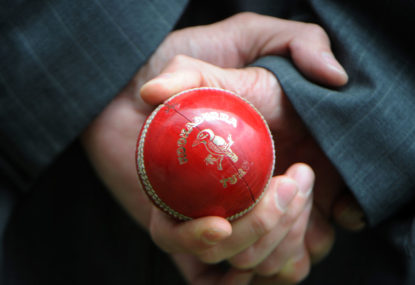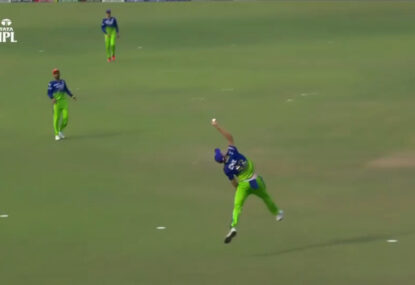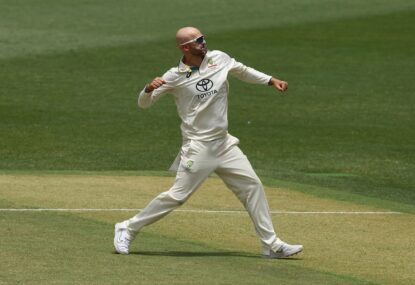Sunday night’s abandonment of the JLT One Day Cup game between New South Wales and Victoria at North Sydney Oval was about the only mainstream headline the competition has generated so far.
Fierce rivals in the Bushrangers and Blues going head to head, with the likes of Mitchell Starc and Pat Cummins up against Australia’s middle order batsman Peter Handscomb, and seemingly no one could give a bull’s roar.
At least not the television networks who have given the competition a wide berth for the first time in living memory.
Granted the Domestic 50-over game has never been a huge crowd puller or coveted big media attention, however the fact it has become completely invisible is concerning in its own right.
North Sydney Oval is a fantastic little ground, and is an ornament to the domestic game, with the venue having hosted a number of terrific List A fixtures over the past decade.
While other venues like Blacktown, Bankstown and Drummoyne have struggled at times with either poor surfaces or poor crowds, North Sydney generally has a great atmosphere with its intimate surroundings and well-curated playing surface.
They have only just recently converted the ground to drop-in wickets, due to pressure from the football codes, with North Sydney hosting a number of winter teams like the Bears, Norths Rugby, and Soccer games here and there.
Without knowing exactly what went on, it seems a truly bizarre decision by the umpires to abandon a game that had been going for over 70 overs, and in which a few batsmen were rapped on the gloves.
Have we become so precious that an uneven wicket causes us to shake hands and abandon a game?
The Blues played poorly and would have lost the game regardless. However, the whisper is they were punished because they had Mitchell Starc and Pat Cummins targeting a dicey spot on the wicket under the floodlights.
If that is cause to abandon the game, then the contest between bat and ball might really be dead and buried.
The fact that there was no announcement by anyone to the crowd as to exactly why the players were shaking hands, and no decision made by Cricket Australia as to whether a bonus point should be award to Victoria until 90 minutes after the game, just adds to the embarrassment for the game of cricket.
The only people that really know what is going on in this year’s JLT Cup on the field are the cricket tragics, who are prepared to sit on computers with a live stream, watching footage with camera angles from back in the 1980s from behind the wicketkeeper.
The fact that this competition has disappeared off our television screens altogether, with Channel Nine not even offering it on its back up stations, shows the lack of appetite or vision for what has become a hastily run tournament, and almost an inconvenience for Cricket Australia.
It seems strange, really, that Cricket Australia and the Networks haven’t come together to promote the tournament during a quiet period in the Australian sporting calendar.
We saw on the weekend Racing NSW heavily promote The Everest, a new horse race, which drew 33,000 fans to Randwick, the biggest crowd since they built the new grandstand at Randwick.
Now, not for a second am I suggesting that Cricket Australia have the same budget to work with as Racing NSW – however, the fact is Racing NSW identified a period of the year in which they could get maximum exposure, and poured everything into promoting it with spectacular results.
These were not necessarily all the best horses in the country, nor was the race given Group 1 status, but everyone in Sydney certainly knew months in advance it was on, and it proved a winner. Doubtless to say it will be even bigger next year.
With both major footy codes’ seasons in the NRL and AFL over, and a gap before the Ashes and BBL, October/November is a time when most ardent sports fans are left scratching around for options.
If cricket is truly considered our national game, then why is a tournament containing our best State players, and some Australian players, disappearing completely from sight?
No disrespect to the A League and the NBL, however, they contain players that are not even close to the best in the world, while cricket has some of the best players in the world playing right in our own backyard.
Yet it is being pushed aside by fringe sports like football and basketball that have previously been scoffed at for years in this country.
Really, the JLT Cup has been losing relevance ever since the format was crammed into October at the start of the Australian summer to make room for the Big Bash.
Think about this – Victoria and South Australia have not hosted a domestic 50-over game for over five years. Players from those States have not played at their home ground for that period of time.
Treasured grounds like the MCG and Adelaide Oval would be a highlight for a domestic player to play on; however they have to make do with Grade grounds like Bankstown, Drummoyne and Hurstville – all nice grounds, in their own right, but they certainly don’t hold the same aura or standing as the major Test venues around the country.
The lack of atmosphere or crowds at Domestic Cricket is nothing new in this country. However, magnified a few times when two States are clashing in a neutral State makes for an embarrassing product, which is perhaps why Channel Nine decided to cut its losses with the 50-over domestic game.
For instance, in the past we have had clashes like Tasmania versus Western Australia, played at Blacktown in Sydney, which looked like a game being played on the moon in the glow of night.
This year’s final will be played in Tasmania, with organisers probably desperately hoping the home State can win a surprise berth in the finals so more than a couple of hundred people show up.
There is a genuine argument that more spectators would be found at Grade Cricket than some JLT Cup games over the past five years, and certainly at Club Rugby, another semi-amateur level of sport.
It’s a shame, because back when I was growing up these State rivalries had some exposure, and a proper place on the cricket fixture list throughout the season.
They would often be played on a Sunday, after a four-day Shield match. Not only did it provide an opportunity for a State to get revenge for a Shield loss, but it also gave players trying to break into representative teams additional opportunities throughout the season.
These days, if you want to break into the Australian ODI team, runs in the BBL are probably more important, given the ODIs are played in January in Australia.
Even going back to five years ago, the 50-Over domestic competition held marquee games on Fox Sports on Wednesdays.
The Day/Night games, for me, were something to look forward to during uneventful periods of the year, sporting wise, like October and November. They were often played at the main venues of the home State and often drew at least some sort of crowd and were well covered by Fox Sports.
Recently I saw some footage on Facebook of Shane Warne bowling to a young Michael Clarke in a domestic 50-over game on a Sunday at the SCG, in the middle of the season. It would have been sometime in the early 2000s. There was a decent crowd at the SCG and, I would assume, a captivated audience sitting at home in front of the TV.
Sometimes, as a true cricket fan, State contests can be even more compelling than when Australia takes on a weak nation, or play a meaningless Test Series, including dead rubbers and one-sided contests. There was a time when you could argue State contests in Australia were the strongest games of cricket you could find anywhere in the world, when the national side was dominating in the late 1990s and early 2000s.
While it’s hard to feel sorry for most of the Domestic players, given the BBL has increased their pay packets, exposure and popularity to a wider audience, the players that don’t cut it at T20 level are certainly left behind.
State contracted players that are not good enough for T20 cricket will spend three months in the middle of the season toiling away in Grade cricket irrelevance.
The cricket season in Australia is generally considered to be from October to March. However, really, in recent years it has become purely a sport that only gets back page headlines from late November until February.
Outside of the Test Matches, particularly the Boxing Day and New Year’s Test, and the BBL, the start and end of that October to March period are now swallowed up by other sports.
I could make an argument that the past two Test summers in Australia have been completely lifeless and forgettable. The last two Boxing Day and New Years Test matches offered up a third-string West Indies side and an average, but not great, Pakistan side.
No doubt, the Ashes will draw big crowds and ensure cricket is front and centre this summer, but what about future Test summers outside of Ashes’ contests?
To be honest I’m not really sure what the solution is for competitions like the JLT Cup, other than to say it would nice to see at least a few 50-over games tacked on to the end of Shield games, with each team getting a couple of home games at major venues.
I have to say I am a huge fan of the BBL. It’s hard to make a case that its popularity and success will diminish in the short term. It has brought a whole new fan base to cricket, as well as given domestic players a real profile and launching pad.
It has the perfect timeframe of the school holidays, in amongst some good weather, and a lack of other competitions during night times in December and January.
The games are generally well contested, and the quality of cricket is pretty good. I think they need to be careful, however, with adding too many teams and increasing the schedule, as more could well mean you lose the quality and the event type feel to it.
Less is more, in some respects, and they can tilt that balance towards over exposure with more games, and more teams.
Sacrificing Sheffield Shield games hardly seems like a great option either, given that Australia are already struggling to find the same production line as they have relied upon, to forge a couple of decades of success and great depth in both batting and bowling.
Overall you wouldn’t necessarily say cricket in this country is struggling, given the raging success of T20 cricket, but it has led to the over-saturation of players, and the game overall, across the world.
This is why the build up to this Ashes series is being met by some apathy. All these pop-up Leagues have led to some cricket losing its meaning, with International players playing all over the world for different sides around the clock.
Which is why the newly introduced Test and ODI Championship is a long time coming from the ICC, it adds some meaning.
People used to look forward to an Australian Summer with relish; however, given cricket virtually takes place twelve months of the year around the world, it seems like this Ashes Series has a little bit of a feel of being “just another series”.
The JLT’s virtual disappearance may not seem to matter when the Ashes and BBL are in full swing, however it may be a smaller sign of a deeper malaise for the game.
Because if the BBL stagnates, and we have more dull Test summers like the past two, the game as a whole in this country, in all three formats, may no longer be able to paper over the cracks.





































































































